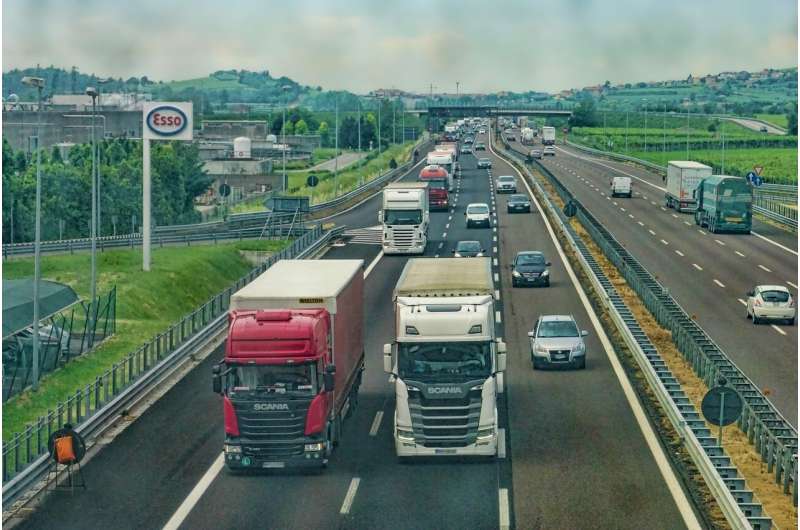Credit: CC0 Public Domain
There's a reason California is the largest zero-emission vehicle market in the country. If automakers want to sell cars in the state, then a certain percentage of their vehicles must be electric models.
The zero-emission vehicle mandate has pushed manufacturers to produce innovative clean cars. As a result, there are now some 40 electric models to choose from, with more on their way. Half of all pure electric vehicles are sold in California. But perhaps as important, 10 other states have adopted California's regulation—meaning the Golden State's decision to demand zero-emission vehicles is helping clean the air and give consumers clean-car choices across the country.
Now, California is looking to do the same with commercial trucks.
The California Air Resources Board is considering an Advanced Clean Truck regulation that would require about 20% of new trucks sold in the state by 2030 to be zero-emission models. The rule would apply to larger trucks on the road, including delivery vans, heavy-duty pickups used to tow trailers, box trucks and big rigs.
There are some 70 different kinds of zero-emission trucks on the market, mostly from startups and smaller companies. The proposed rule is aimed at prodding major manufacturers to get off the sidelines and move faster to roll out electric and fuel-cell models.
State officials say it's the most ambitious regulation of its kind in the world, and yet it's probably not ambitious enough.
Despite California's aggressive efforts to cut air pollution and the greenhouse gases responsible for climate change, the transportation sector remains the state's Achilles' heel. While there has been tremendous progress with clean power generation and cleaner industrial operations, the state's largest source of greenhouse gases—transportation—has seen emissions increase in recent years.
Heavy-duty vehicles in particular are responsible for a disproportionate share of the pollution. Trucks and buses make up just 7% of the vehicles on the road in California, but 20% of the greenhouse gases and 40% of the smog-forming emissions. Diesel exhaust is a toxic air contaminant, and heavily used truck corridors can be so dirty and unhealthy that physicians call them "diesel death zones."
If California is ever going to clean the air enough to meet federal health standards or the state's ambitious climate change goals, then the state has to be far more aggressive in weaning the transportation sector off fossil fuels. That means pushing truck manufacturers to make more zero-emission models sooner.
Many of the world's leading manufacturers have already said their future is in zero-emission vehicles. And there's growing interest from the business sector in buying such vehicles. Electric trucks are particularly well suited for city driving and delivery routes less than 100 miles per day. Amazon announced in September that it was ordering 100,000 electric delivery vans from Rivian, an electric vehicle startup based in Michigan. Last year, Anheuser-Busch ordered up to 800 hydrogen-electric semi-trucks from Nikola, another clean-truck startup. UPS, Pepsi and Walmart have ordered Tesla's electric semi-truck, which is slated to begin production next year.
Communities have been promised clean trucks. The ports of Los Angeles and Long Beach, which together make up the largest single source of pollution in Southern California, have pledged to allow only zero-emission trucks at the port complex by 2035. Mayor Eric Garcetti and regional leaders set a goal that 40% of short-haul trucks and 60% of medium-duty delivery trucks will be electric by 2028.
But those pledges and goals are dependent on the availability of clean trucks to replace or augment the fossil-burning ones currently in use. The proposed California Air Resources Board regulation would require truck makers to sell a certain percentage of zero-emission trucks starting in 2024, with the share increasing each year. In 2030, roughly 20% to 25% of new trucks sold would be zero-emission.
And yet the proposal isn't as powerful as it sounds. Because the rule wouldn't affect existing trucks and would allow the vast majority of new trucks to use conventional fuels, it would result in just 4% of the trucks on the road in 2030 being zero-emission models. Environmentalists say that's not ambitious enough, and they're right.
The free market alone will never work fast enough to wean us from our dependence on fossil fuels. And as long as President Trump is in office, the federal government won't do it either; his administration is trying to take away California's authority to force automakers to sell clean vehicles in this state. That's one more reason why California continues to lead and push car and truck makers to deliver a cleaner, healthier future sooner.
©2019 Los Angeles Times
Distributed by Tribune Content Agency, LLC.






















